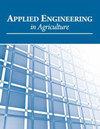Preliminary Investigation of Convergent Evolution-Inspired Serrated Structure for Optimization of Mini Rotavator Blade’s Cutting-Edge
IF 0.8
4区 农林科学
Q4 AGRICULTURAL ENGINEERING
引用次数: 0
Abstract
Highlights An alternative bioinspired perspective that focuses on analogous geometrical features of soil animals was proposed. Reverse-engineering technique was adopted to build the virtual prototype of mini-rotavator’s blades. EDEM investigation along with soil bin experiment were conducted to evaluate blades’ performance and reveal the soil-blades interaction mechanism. The tillage tools designed by convergent evolution-inspired approach could increase their availability in underdeveloped hilly and mountainous areas. Abstract. High resistance torque and energy consumption severely limit the applications of mini rotavators in underdeveloped hilly and mountainous areas. From the perspective of convergent evolution, this study proposes an alternative optimization approach that takes a broader perspective and focuses on analogous structures of soil animal claws that serve the functions of efficient soil burrowing. Experimental investigations were carried out to test the hypothesis that serrated structures with certain geometrical parameters could have the potential of reducing penetrating resistance and improving energy efficiency of rotary soil-engaging component. By taking mini rotavator’s blade as the research object, the convergent evolution inspired serrated structures were utilized for the design of the blade’s front, side and transition cutting edge. In this investigation, five types bioinspired mini rotavator’s blades were designed and prepared, then their performances were compared with the conventional blade. By taking the length of serrated unit, rotational speed and tilling depth as experimental factors, and the resistance torque as experimental index, quadratic regression rotation orthogonal combination test was conducted. Then, the optimal parameters for the design of bionic blade were determined. Further, the performance of mini rotavator assembled with bionic and conventional blades were evaluated by EDEM. The mechanism of bionic blades for reducing resistance and improving tillage efficiency was investigated. Soil bin experiments indicated that the optimal parameters combination was length of serrated unit of 30 mm, the speed of 165 r/min, and tilling depth of 90 mm. At this condition, the average torque for bionic and conventional blade was 2.97 and 3.82 N·m, respectively. The bioinspired serrated structure reduced resistance torque by 22.25%. To further investigate the interaction behavior between soil and different types of blades, the reverse-engineering technique was used to extract the geometric characteristics and build virtual prototypes of the bionic and conventional blades. Then, the virtual prototypes of blades was meshed with tetrahedral elements. Simulation model was established based on EDEM. The variation behavior of resistance torque and three-dimensional forces of the two types of blades were analyzed. As expected, the simulation results showed that the average torque of the bionic and conventional blade was 2.84 and 3.42 N·m, respectively. EDEM evaluation derived that bioinspired blade reduced resistance torque by 17.0%. The relative error between simulation and measurement ranged between 4.58% and 11.70%, respectively. Thereby, the validity of discrete element model was verified and tillage performance were further analyzed. It was found the soil disturbance resulted from bionic blades was higher than that of conventional blades, which indicated improved tillage quality. Moreover, the breaking bonding Bonds for bionic blade was 72.8%, which was slightly inferior than conventional blades of 75.4%. But both types of blades could meet the tillage reequipment. These results validated that convergent evolution inspired bionic optimization approach has advantageous for the design of rotary soil-engaging implements for improving working quality and reducing resistance. Keywords: Agricultural machinery, Bioinspired serrated structure, Bionics, Convergent evolution, Discrete element, Mini rotavator, Reverse engineering, Soil-engaging component.基于收敛进化启发的锯齿结构在小型旋转叶片尖端优化中的初步研究
提出了另一种生物启发的观点,侧重于土壤动物的类似几何特征。采用逆向工程技术建立了微型旋转机叶片的虚拟样机。通过EDEM研究和土槽试验对叶片性能进行了评价,揭示了叶片与土壤的相互作用机理。采用趋同进化方法设计的耕作工具可以提高欠发达丘陵和山区的可利用性。摘要高阻转矩和高能耗严重限制了小型旋转器在欠发达丘陵山区的应用。本研究从趋同进化的角度出发,提出了另一种优化方法,该方法具有更广阔的视角,并将重点放在土壤动物爪子的类似结构上,这些结构具有有效的土壤挖洞功能。通过实验研究,验证了具有一定几何参数的锯齿结构具有降低旋转吸土部件穿透阻力和提高能量效率的可能性。以小型旋涡机叶片为研究对象,采用收敛演化启发的锯齿结构对叶片的前、侧、过渡切削刃进行设计。设计并制备了5种仿生微型旋转器叶片,并与传统叶片进行了性能比较。以锯齿单元长度、转速和耕深为试验因素,以阻力转矩为试验指标,进行二次回归旋转正交组合试验。然后,确定了仿生叶片设计的最佳参数。在此基础上,利用EDEM对装配仿生叶片和常规叶片的微型旋转器进行了性能评价。研究了仿生叶片降低阻力、提高耕作效率的机理。土槽试验表明,最佳参数组合为锯齿单元长度为30 mm,速度为165 r/min,耕作深度为90 mm。在此条件下,仿生叶片和常规叶片的平均扭矩分别为2.97和3.82 N·m。仿生锯齿结构降低了22.25%的阻力扭矩。为了进一步研究土壤与不同类型叶片之间的相互作用行为,采用逆向工程技术提取了仿生叶片和传统叶片的几何特征,并建立了虚拟样机。然后,用四面体单元对叶片虚拟样机进行网格划分。基于EDEM建立了仿真模型。分析了两种叶片的阻力转矩和三维力的变化规律。仿真结果表明,仿生叶片和常规叶片的平均扭矩分别为2.84和3.42 N·m。EDEM评估得出,仿生叶片减少了17.0%的阻力扭矩。仿真与实测的相对误差分别为4.58% ~ 11.70%。从而验证离散元模型的有效性,并进一步分析耕作性能。结果表明,与传统叶片相比,仿生叶片对土壤的扰动更大,有利于提高耕作质量。此外,仿生叶片的键断率为72.8%,略低于常规叶片的75.4%。但两种类型的叶片都能满足耕作再装备的要求。这些结果验证了收敛进化启发的仿生优化方法对旋转吸土器的设计具有提高工作质量和减小阻力的优势。关键词:农业机械,仿生锯齿结构,仿生学,收敛进化,离散元件,微型旋转器,逆向工程,土壤啮合部件
本文章由计算机程序翻译,如有差异,请以英文原文为准。
求助全文
约1分钟内获得全文
求助全文
来源期刊

Applied Engineering in Agriculture
农林科学-农业工程
CiteScore
1.80
自引率
11.10%
发文量
69
审稿时长
6 months
期刊介绍:
This peer-reviewed journal publishes applications of engineering and technology research that address agricultural, food, and biological systems problems. Submissions must include results of practical experiences, tests, or trials presented in a manner and style that will allow easy adaptation by others; results of reviews or studies of installations or applications with substantially new or significant information not readily available in other refereed publications; or a description of successful methods of techniques of education, outreach, or technology transfer.
 求助内容:
求助内容: 应助结果提醒方式:
应助结果提醒方式:


